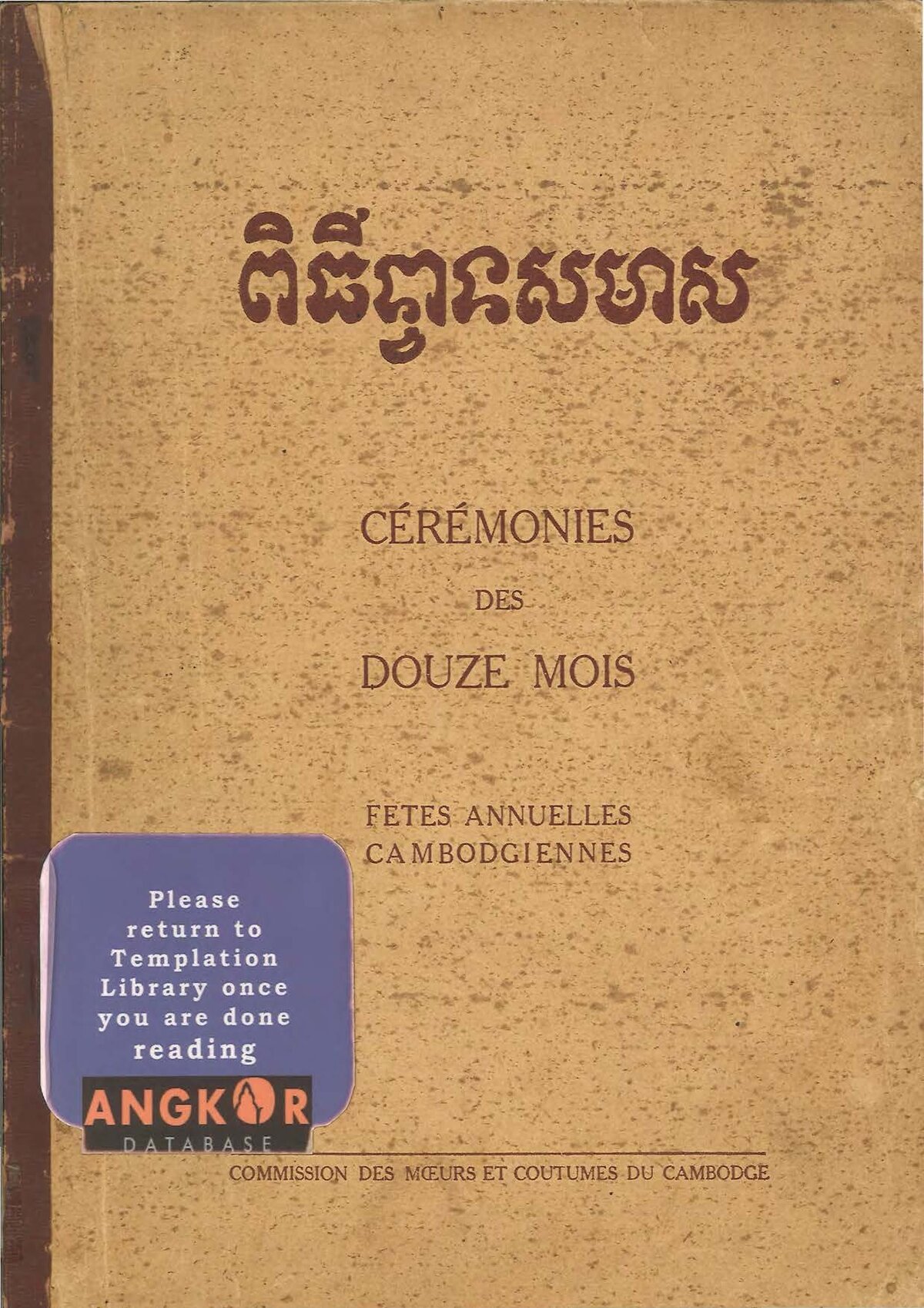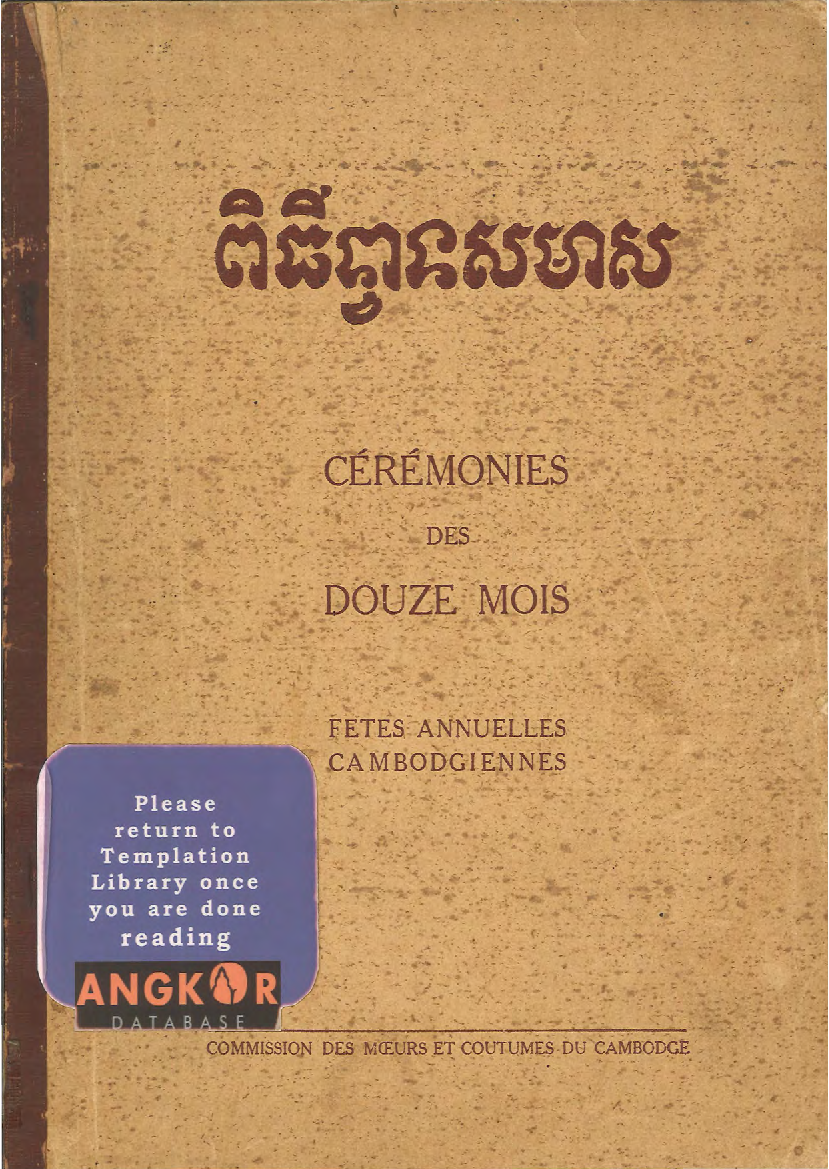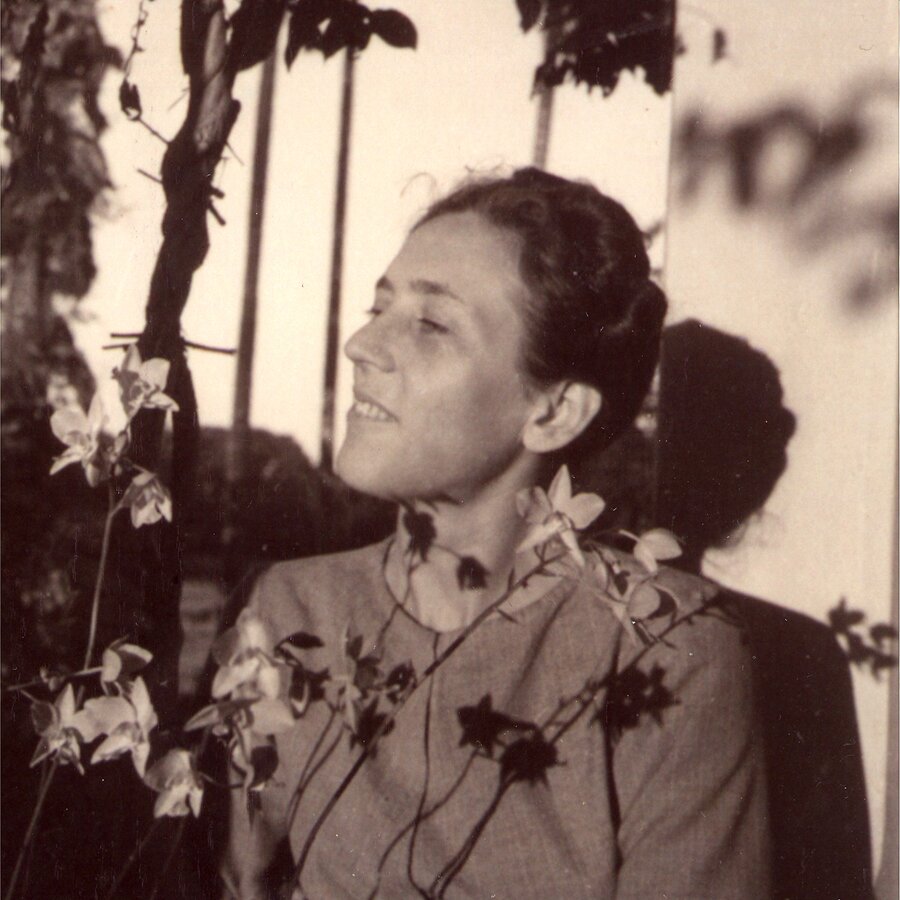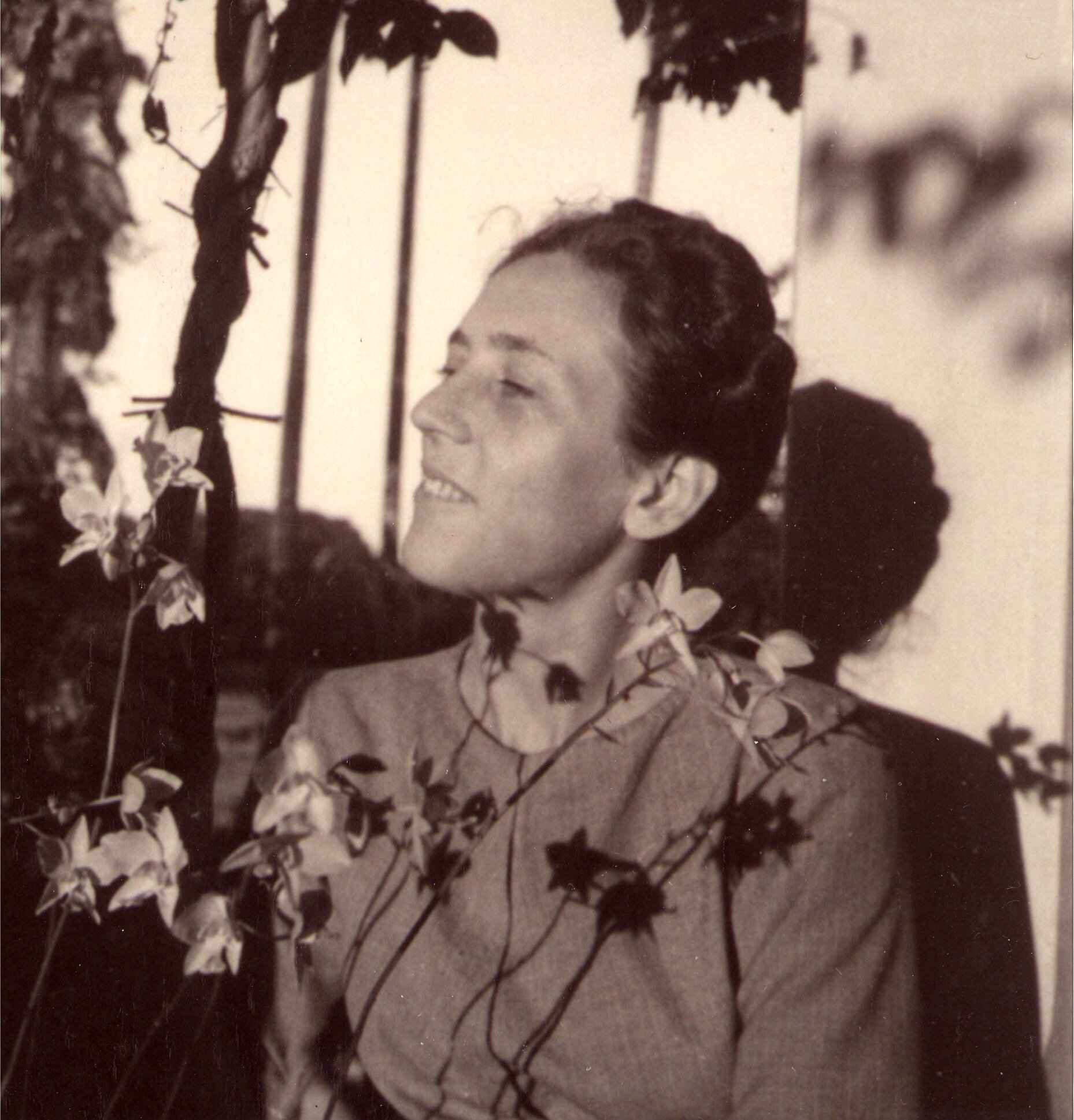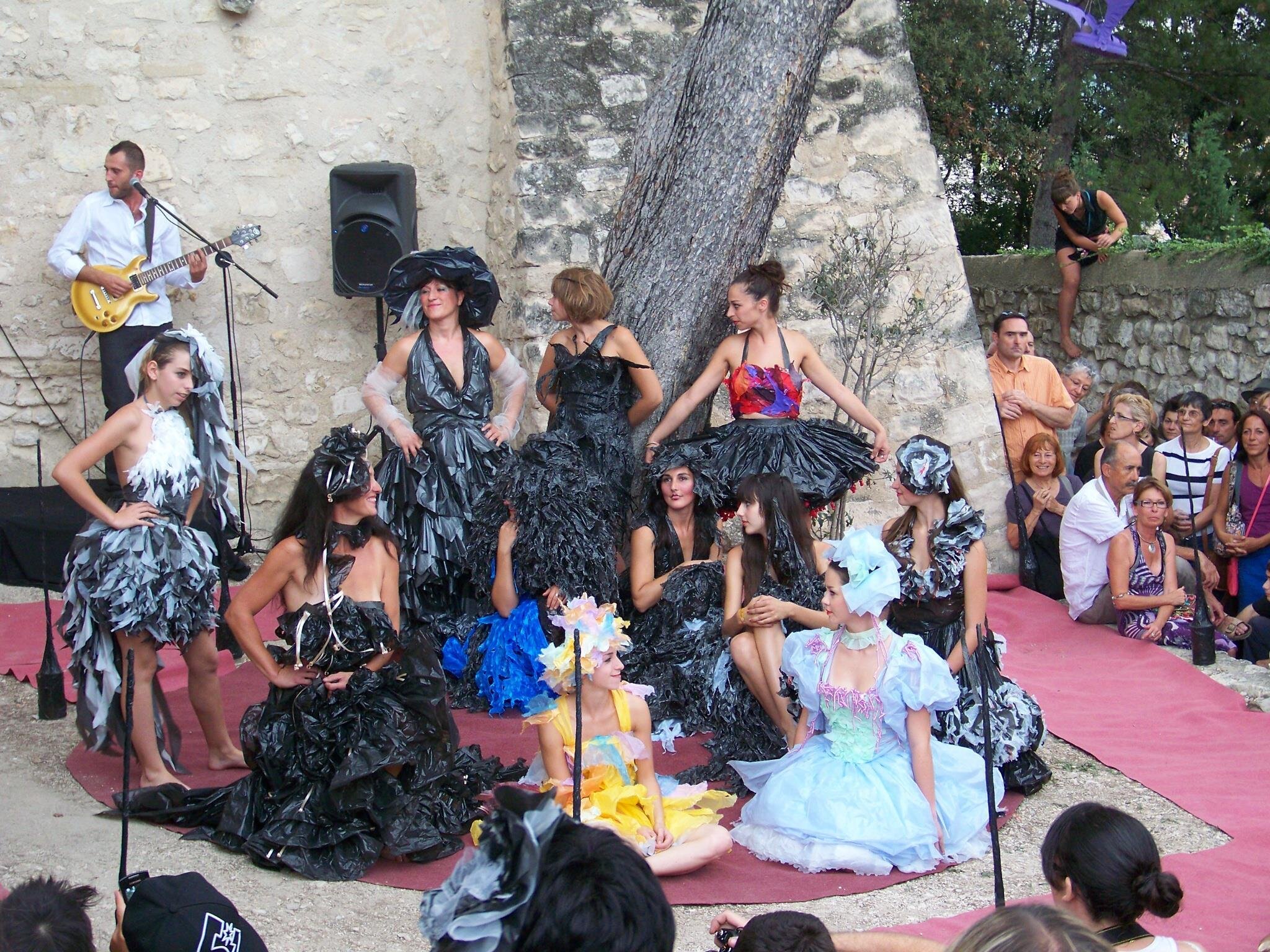From the “coming into a New Year” to the monks retreat at the start of the rainy season to the celebrations of Water Festival, this documented study describes traditions, folk tales and religious ceremonies linked to the Khmer Year and its particular calendar. Almost one century later, its reading nowadays illustrates the permanency of rites and customs inscribed in the Khmer cultural universe.
The short book gives important information about the following ceremonies and holidays:
- Notions sur l’organisation cultuelle au Cambodge [Notes on Religious Organization in Cambodia]
- Le calendrier [Calendar]
- Nouvel-An [New Year]
- Génies fonciers [Neak Ta, Local Spirits]
- La cérémonie du labourage royal [Royal Ploughing Ceremony]
- Pleine lune de Vissakh [Vissakh Full Moon]
- Rites d’ordination [Ordination Rites]
- Le Vossa [Three-Month Retreat of the Monks]
- La Quinzaine des Morts [Fortnight of the Dead]
- La sortie du Vossa [Leaving Vossa]
- La fin de la saison des pluies [End of Rainy Season]
- Fetes d’anniversaire royal [Royal Birthday Festivities]
- Cerfs-volants [Kites]
- La pose des Seima [Placing the Seima]
- Fetes du “Troisieme Month” [“Third Month” Festivities]
- Exorcismes de fin d’année [End-of-the-Year Cleansing]
- Annexe: Cycle des soixante ans [Sixty-Year Cycle Table]
Here is the chapter (pp 19 – 24) dealing with New Year ceremonies, original text followed by our translation:
Nouvel-An | New Year
Les fêtes du Nouvel-An sont, pour les Cambodgiens, celles de «l’entrée dans l’année nouvelle» col chnàm thmei. Mais en réalité, il y a deux «entrées », col, l’une basée sur la marche de la lune et marquant un changement dans le cycle des douzes animaux, l’autre calculée d’après la marche du soleil et marquant le début de l’année civile. Comme la première “entrée” a toujours lieu le premier jour du mois de cèl, tandis que la seconde, variable par rapport aux phases de la lune, coïncide avec le 12 ou, plus souvent, le 13 avril; l’espace compris entre les deux «entrées» est plus ou moins long suivant les cas.
Ainsi, en 1949, l’année du rat finissait, et l’annéedu boeuf commençait, le premier jour de la quinzaine claire de cèt, soit le 30 mars, tandis que l’année 1311 de la Petite Ère, et, pour le calendrier civil, l’an 2492 de l’Ère bouddhique commençaient le 13 avril, soit le 15 lune croissante de cèt.
Seule, de nos jours, la seconde « entrée » est solennellement fêtée, les astrologues royaux décidant si les célébrations doivent durer trois ou quatre jours; mais le rite le plus important, celui des phnom khsàc «monts de sable » peut commencer dès le début de cèt et s’accomplir tout le mois. Les monts de sable, dit-on le plus souvent — car les traditions varient — doivent représenter les grandes montagnes de la cosmologie indienne avec, au centre, le Mont-Meru, axe du monde, les autres étant situées aux points cardinaux et intercardinaux. La tradition lettrée veut que le «mont » central symbolise le Pràh Colamonei, stupa céleste où furent enfermés les cheveux que le Buddha coupa quand il quitta la vie princière. Comme pour bien des coutumes anciennes, il y a, de nombreuses explications du rite. La plus populaire raconte par une légende comment chaque grain de sable, déposé par le fidèle, délivre d’un pêché. Les phnom-khsàc sont entourés d’une enceinte à quatre portes exactement orientées. En dehors de celles-ci, des autels aux divinités de l’espace sont érigés aux points cardinaux et intercardinaux. Un neuvième autel, doublant celui de la divinité régente de l’est, est destiné à Pràh Yumorac, l’Auguste Yâma Roi, le dieu des enfers.
A Phnom-Penh, quelques jours avant les célébrations du Nouvel An, le roi prend part ·à la cérémonie des « monts de sable » sur la terrasse , de la pagode située au sommet de la petite éminence qui donne son nom à la ville et que la tradition associe à sa fondation. Là s’élève un grand stupa qui fut bâti au début du XV me siècle par le roi Ponha Yat. Un bangskol a lieu près de ce stupa et de ceux, plus petits, qui se trouvent au pied de la butte. Le bangskol est une prière en l’honneur des morts, où l’officiant se trouve en relation avec le cadavre, le cercueil ou le reliquaire (en l’espèce le stupa) au moyen d’une bande d’étoffe qu’il tient en priant.
En outré, des « monts de sable » sont élevés dans la Pagode d’Argent, celui du centre occupant l’intérieur du temple. Le Roi fait solennellement une triple circumambulation autour de ces “monts”, puis y jette une poignée de sable blanc apporté de Longvêk et y plante fleurs et oriflammes. La famille royale et les hauts dignitaires l’imitent, mais avec du sable roux du Mékong. Le rite se termine par la récitation de textes sacrés par les bonzes, auxquel sont présentés des vêtements de bain. Cette érection de «monts de sable» n’a pas une date fixe par rapport aux cérémonies royales du Nouvel-An dont l’ordonnance n’est pas d’une rigueur absolue. (1)
Le premier jour du col chnàm est appelé sangkràn’, du sanskrit sunykranti signifiant “marche”. C’est alors que le soleil entre dans un nouveau signe du zodiaque.
Selon une curieuse légende, qui symbolise d’anciennes conceptions astronomiques, Kabel Mohà Prohm (2) posa trois énigmes à un grand sage nommé Thomobàl (3). S’il n’y trouvait pas réponse, Thomobàl serait décapité, mais s’il réussissait, Kabel s’engageait à avoir la tête coupée. Thomobàl eut la chance d’entendre, avant la date fixée, un
couple d’aigles discuter des énigmes, et put donner les réponses. Kabel devait donc subir la décollation. Mais sa tête, en touchant la terre, l’aurait brûlée tout entière ; jetée dans les cieux, elle aurait à jamais empêché la pluie ; plongée dans l’Océan, elle l’aurait tari ‑jusqu’à la dernière goutte. Kabel fit venir ses sept filles pour leur recommander de
prendre garde, et de recevoir la tête sur un plateau. Ayant dit, il se trancha le chef, et le tendit à son aînée, Tungsa. Depuis lors, chacune des sept filles, à tour de rôle, porte la tête sur un plateau d’or et fait ainsi le tour du Mont Meru pendant soixante náti, c’est-à-dire une journée entière (4).
Suivant que le sangkràn’ tombe en tel ou tel jour de la semaine, c’est l’une ou l’autre des sept déesses qui, montée sur l’animal qui lui est propre, et portant la tête de son père, conduit la procession des dieux et des déesses autour du Meru. Ainsi, lorsque le sangkràn’ tombe un dimanche, Tungsa mène le cortège, montée sur un garuda. L’influence de la déesse conductrice du cortège des dieux le jour du sangkràn’ s’étend sur toute l’année, et les almanachs annoncent le bonheur ou le malheur qui s’ensuivront.
Au moment du sangkràn’, le Roi arrive au son des conques devant l’autel dressé en face de la salle du trône, pour saluer les divinités gardiennes du monde et du royaume. Le 55Chef des Astrologues les invoque en pâli, les priant d’accorder au Roi et à la Cour, aux fonctionnaires et à tout le peuple khmèr la santé, le bonheur, la paix et l’abondance. De nouveau, le Roi salue, tandis que, par trois fois, les bàku sonnent les conques (5) et l’orchestre joue, par trois fois, l’air Sàthukàr (bonne action).
Le rite suivant, dans l’ordre habituel des cérémonies, est le bain du Roi, au moment fixé par les lzàrà. On remplit d’eau, bénite par des moines bouddhiques, un grand vase de bronze posé sur un support. Au pied de ce support, le roi, vêtu de blanc, s’assied face au “soufflé de vie” dont la direction change suivant le jour de la semaine, le “soufflé de mort” venant toujours en sens exactement contraire. Le chef des bàku puise de reau dans le vase et la verse sur le souverain, puis lui présente, dans une conque, un peu d’eau dont il s’humecte la figure et les cheveux. Cependant le bàku récite une formule pour éloigner les malheurs.
Ce même jour, le Roi asperge d’eau parfumée les statues des Panhca Ksetr, qui sont les dieux Çiva, Nârâyana, Baladêva, Ganeça et Uma.
Le dernier jour de fête est nommé long sàk et considéré comme celui où l’on entre définitivement dans la nouvelle année. Au Palais, le Roi asperge d’eau parfumée l’image du Buddha et préside au bain des bonzes qui, ensuite, célèbrent le bangskol pour les morts de la famille royale.
Ce même jour, princes et princesses, fonctionnaires de la capitale et leurs femmes, viennent souhaiter bonheur et longue vie à leur Souverain, lui présentant des fleurs, du parfum, et des bougies en nombre
correspondant à leur rang.
Naguère, tous devaient prêter serment, ce qu’ils faisaient à nouveau six mois plus tard (6) et, au cours d’un grand défilé militaire, des baku aspergaient d’eau bénite les quatre corps d’armées. Ensuite avaient lieu des courses d’éléphants, puis de chevaux, des combats entre hommes et éléphants, des matchs de boxe et de lutte (7).
Partout dans le Cambodge, dans l’enceinte des monastères ou dans les enclos des maisons, s’élèvent des « monts de sable ». Chez les particuliers, ils sont de dimensions réduites, et placés sur une sorte de table ; dans la région de Siemréap, où les « monts », particulièrement raffinés, ont une forme de stupa, ceux qui sont ainsi faits en miniature
sont aussi élégants que les plus imposants de ceux qu’on voit dans les pagodes. Dans cette même région, les phnom khsàc se font auprès des banians, arbres vénérés parce que, sous l’un d’eux, le Buddha obtint l’Illumination. Là, si l’on né fait pas la grande cérémonie, avec cinq ou neuf «monts» entourés d’une enceinte ouverte aux points cardinaux,
chaque banian est doté de sa petite montagne particulière, où le fidèle piqué des bannières de papier, des bougies et des baguettes d’encens, et dépose quelques offrandes.
Mais la plupart du temps on élève des « monts de sable » dans les pagodes, généralement dans l’après-midi, la veille du jour fixé pour la fête; ceux qui n’ont pu participer à leur fabrication jettent plus tard, à leur base, quelques poignées de sable. Le matin les fidèles prient, puis offrent le riz aux bonzes, avant de faire trois fois, en procession, le tour des monts. Alors, le maître de cérémonies fait une invocation, demandant le bonheur et la santé pour tous, puis les fidèles piquent leurs bannières de papier, leurs baguettes d’encens, au pied des “monts” qu’ils aspergent d’eau parfumée ou d’eau mêlée de safran. Les variantes sont nombreuses : c’est ainsi que dans tel village les « monts » sont faits de paddy, de riz cru, de riz cuit, de gâteaux.
Très souvent, dans l’après-midi, les fidèles baignent les bonzes; ailleurs, ils baignent les statues du Buddha en demandant que les pluies soient abondantes.
Pendant ces jours de fête ont lieux de nombreux jeux qui, le plus souvent, opposent une troupe féminine à une troupe masculine : les plus fréquents sont le jeu de chung, où l’on se renvoie une balle faite d’une écharpe roulée, tout en échangeant des chansons, et celui d’angkûnh, du nom de grosses graines dures et légèrement aplaties, qui servent de quilles.
Il existe pour le Nouve!-An des coutumes locales particulières. C’est ainsi que, dans les régions de Siemréap, Battambang et Pursat ont lieu ce qu’on appelle les « danses de trott ». Des troupes de villageois s’en vont quêter de porte en porte, en dansant et chantant. L’un d’eux chevauche un bâton courbe, portant à l’une des extrémités un massacre de cerf, et à l’autre un long panache d’herbes sous lequel pend une clochette ; deux hommes masqués feignent de tuer le « cerf » de leurs fusils de bois. Le produit.des quêtes est apporté à la pagode.
Dans la province de Kandal, on peut également citer des coutumes particulières. A tel village situé sur le Mékong, deux groupes de femmes miment des courses de pirogues à l’intérieur du temple : le rite, dit-on, était destiné à se propitier les crocodiles qui, jadis, étaient nombreux. Dans tel autre village les génies demeurant ·dans des arbres
proches de la pagode, prennent possession de leurs desservants, pour promettre aux habitants le bonheur et la prospérité.
Partout où se dressent les ruines de temples datant de la puissance khmère, les Cambodgiens ont coutumes de se réunir au Nouvel-An. Des milliers de personnes, dans leurs plus beaux autours viennent ainsi, chaque Nouvel-An, dans les ruines d’Angkor-Vat, prier et festoyer, reprennant, pour quelques heures, contact avec les splendeurs du passé.
(1) En 1949, les rites des «monts de sable» eurent lieu avant «l’entrée dans l’année nouvelle», les 4 et 5 avril au Phnom, les 8 et 9 avril à la Pagode d’Argent — le 4 et le 8 étant consacrés à la fabrication des «monts» à laquelle n’assiste pas le souverain.
(2) Suivant l’étymologie, Kapila le Grand-Brahmane.
(3) En sanskrit, Dharmapâla, Gardien de la Loi; le mot dharma désignant aussi bien la loi morale (c’est le nom que les bouddhistes donnent à l’enseignement de leur Maître) que l’ordre qui régit les phénomènes physiques.
(4) De nos jours, le náti est assimilé à la minute.
(5) Les rites royaux sont toujours soulignés par le bruit des conques trois fois répété; nous né le mentionnerons plus à l’avenir.
(6) Actuellement, il n’y a plus qu’une prestation de serment, coïncidant avec l’anniversaire du Roi.
(7) Seule subsistent les séances de boxe, devant la salle du trône. En dehors de l’enceinte du Palais, des divertissements sont offerts au peuple.
[The New Year celebrations mark for the Cambodians the “entry into the new year”, chaul chnàm thmei. There are in fact two “entrances”, one based on the movement of the moon and marking a change in the cycle of the twelve animals, the other calculated according to the movement of the sun and marking the beginning of the calendar year. As the first “entrance” always takes place on the first day of the month of chel, while the second, variable in relation to the phases of the moon, coincides with April 12 or, more often, April 13, the space between the two “entries” is more or less long, depending on the case.
Thus, in 1949, the year of the rat ended, and the year of the ox began, on the first day of the clear fortnight of chet, i.e. March 30, while the year 1311 of the Little Era, and, for the calendar civil, the year 2492 of the Buddhist Era began on April 13, i.e. the 15th day of the waxing moon.
Today, only the second “entrance” is solemnly celebrated, the royal astrologers deciding whether the celebrations should last three or four days; but the most important ritual, that of the phnom khsàc “mountains of sand” can begin at the beginning of this summer and be performed throughout the month. The sand mountains, it is most often said — because traditions vary — must represent the great mountains of Indian cosmology with Mount Meru, axis of the world, at the center, the others being located at the cardinal and intercardinal points. Literary tradition has it that the central “mount” symbolizes the Pràh Colamonei, a celestial stupa where the hair that the Buddha cut when he left princely life was locked up. As with many ancient customs, there are many explanations of the rite. The most popular tells through a legend how each grain of sand, deposited by the faithful, delivers one from a sin. The phnom-khsàc are surrounded by an enclosure with four exactly oriented doors. Apart from these, altars to space deities are erected at the cardinal and intercardinal points. A ninth altar, doubling that of the regent divinity of the east, is intended for Pràh Yumorac, the August Yâma Roi, the god of the underworld.
In Phnom Penh, a few days before the New Year celebrations, the king takes part in the ceremony of the “sand mountains” on the terrace of the pagoda located at the top of the small eminence which gives its name to the city and that tradition associates with its foundation. There stands a large stupa which was built at the beginning of the 15th century by King Ponha Yat. A bangskol takes place near this stupa and those, smaller, which are at the foot of the mound. The bangskol is a prayer in honor of the dead, where the officiant is in relation to the corpse, the coffin or the reliquary (in this case the stupa) by means of a strip of cloth which he holds while praying.
In addition, “sand mountains” are raised in the Silver Pagoda, the central one occupying the interior of the temple. The King solemnly makes a triple circumambulation around these “mountains”, then throws in a handful of white sand brought from Longvek and plants flowers and banners there. The royal family and high dignitaries follow suit, yet with red sand from the Mekong River. The rite ends with the recitation of sacred texts by the monks, to whom bathing clothes are presented. This erection of “mountains of sand” does not have a fixed date compared to the royal New Year ceremonies, the order of which is not absolutely rigorous. (1)
The first day of chaul chhnàm is called sangkràn’, from the Sanskrit sunykranti meaning “walk”. This is when the sun enters a new sign of the zodiac.
According to a curious legend, which symbolizes ancient astronomical conceptions, Kabel Mohà Prohm (2) posed three enigmas to a great sage named Thomobàl (3). If he did not find an answer, Thomobàl would be beheaded, but if he succeeded, Kabel agreed to have his head cut off. Thomobàl had the chance to hear, before the set date, a
couple of eagles discuss the riddles, and were able to give the answers. Kabel therefore had to undergo decapitation. But his head, if it touched the ground, would have burned it completely; thrown into the heavens, it would have forever prevented the rain; plunged into the ocean, it would have dried it up — down to the last drop. Kabel called for his seven daughters to recommend that they take care of it, and receive the head on a platter. Having said this, he cut off his head and handed it to his eldest daughter, Tungsa. Since then, each of the seven girls, in turn, carries the head on a golden platter and thus goes around Mount Meru for sixty náti, that is to say a whole day (4).
Depending on whether the sangkràn’ falls on a particular day of the week, it is one or other of the seven goddesses who, mounted on her own animal, and carrying her father’s head, leads the procession of gods and goddesses around Meru. Thus, when the sangkràn’ falls on a Sunday, Tungsa leads the procession, mounted on a garuda. The influence of the goddess leading the procession of the gods on the day of Sangkràn’ extends throughout the year, and the almanacs announce the happiness or misfortune that will follow.
At the time of the sangkràn’, the King arrives to the sound of conch shells in front of the altar set up opposite the throne room, to greet the guardian deities of the world and the kingdom. The Chief Astrologer invokes them in Pali, begging them to grant the King and the Court, the officials and all the Khmer people health, happiness, peace and abundance. Once again, the King salutes, while, three times, the bàku sound the conch shells (5) and the orchestra plays, three times, the tune Sàthukàr (good deed).
The next rite, in the usual order of ceremonies, is the bath of the King, at the time fixed by the lzàrà. A large bronze vase placed on a support is filled with water, blessed by Buddhist monks. At the foot of this support, the king, dressed in white, sits facing the “breath of life” whose direction changes depending on the day of the week, the “breath of death” always coming in the exact opposite direction. The chief of the bàku draws water from the vase and pours it over the sovereign, then presents him, in a conch, with a little water with which he moistens his face and hair. However, the baku recites a formula to ward off misfortunes.
That same day, the King sprinkles perfumed water on the statues of the Panhca Ksetr, who are the gods Çiva, Nârâyana, Baladêva, Ganeça and Uma.
The last day of the holiday is called long sàk and considered to be the day on which we definitively enter the new year. At the Palace, the King sprinkles the image of the Buddha with perfumed water and presides over the bath of the monks who then celebrate the bangskol for the dead of the royal family.
That same day, princes and princesses, officials of the capital and their wives, came to wish happiness and long life to their Sovereign, presenting him with flowers, perfume, and numerous candles corresponding to their rank. Previously, everyone had to take an oath, which they did again six months later (6) and, during a large military parade, baku sprinkled holy water on the four army corps. Then there were elephant races, then horse races, fights between men and elephants, boxing and wrestling matches (7).
Everywhere in Cambodia, within the walls of monasteries or in the enclosures of houses, “mountains of sand” rise. In private homes, they are small in size, and placed on a sort of table; in the Siemréap region, where the particularly refined “mountains” have the shape of a stupa, those which are thus made in miniature
are as elegant as the most imposing of those seen in pagodas. In this same region, phnom khsàc are performed near banyan trees, trees venerated because, under one of them, the Buddha obtained Enlightenment. There, if we do not perform the great ceremony, with five or nine “mountains” surrounded by an enclosure open to the cardinal points,
each banyan tree has its own little mountain, where the faithful prick paper banners, candles and incense sticks, and leave some offerings.
But most of the time “mountains of sand” are raised in the pagodas, generally in the afternoon, the day before the day fixed for the festival; those who were unable to participate in their manufacture later throw a few handfuls of sand at their base. In the morning the faithful pray, then offer rice to the monks, before going three times, in procession, around the mountains. Then, the master of ceremonies makes an invocation, asking for happiness and health for all, then the faithful stick their paper banners, their incense sticks, at the foot of the “mountains” which they sprinkle with perfumed water or water mixed with saffron. The variations are numerous: this is how in a certain village the “mounts” are made of paddy, raw rice, cooked rice, cakes.
Very often, in the afternoon, the faithful bathe the monks; elsewhere, they bathe the statues of the Buddha, asking for abundant rain.
During these festive days many games take place which, most often, pit a female troop against a male troop: the most frequent are the game of chung, where a ball made from a rolled scarf is thrown back and forth, by exchanging songs, and that of angkûnh, named after large, hard and slightly flattened seeds, which serve as skittles.
There are special local customs for New Year’s Eve. This is how, in the regions of Siemréap, Battambang and Pursat, what are called “trott dances” take place. Troops of villagers go from door to door, dancing and singing. One of them rides a curved stick, bearing at one end a slaughter of deer, and at the other a long plume of grass under which hangs a bell; two masked men pretend to kill the “deer” with their wooden rifles. The proceeds of the quests are brought to the pagoda.
In the province of Kandal, we can also mention particular customs. In a village located on the Mekong, two groups of women mime canoe races inside the temple: the rite, it is said, was intended to propitiate the crocodiles which, in the past, were numerous. In another village the genies reside in trees close to the pagoda, take possession of their servants, to promise happiness and prosperity to the inhabitants.
Wherever the ruins of temples dating from the Khmer power stand, Cambodians have the custom of gathering at New Year. Thousands of people, in their most beautiful surroundings, come every New Year to the ruins of Angkor Wat to pray and celebrate, resuming, for a few hours, contact with the splendors of the past.
(1) In 1949, the rites of the “sand mountains” took place before “the entry into the new year”, on April 4 and 5 at the Phnom, on April 8 and 9 at the Silver Pagoda — the 4 and the 8th being devoted to the making of the “mounts”, which the sovereign does not attend.
(2) According to the etymology, Kapila the Great Brahmin.
(3) In Sanskrit, Dharmapala, Guardian of the Law; the word dharma designating both the moral law (this is the name that Buddhists give to the teaching of their Master) and the order which governs physical phenomena.
(4) Nowadays, náti is equated to minute.
(5) The royal rites being always highlighted by the sound of the conch shells repeated three times, we will not mention it further in the text.
(6) Currently, there is only one swearing-in, coinciding with the King’s birthday.
(7) Only the boxing sessions remain, in front of the throne room. Outside the Palace grounds, entertainment is offered to the people.

